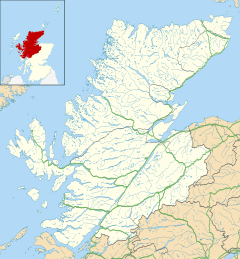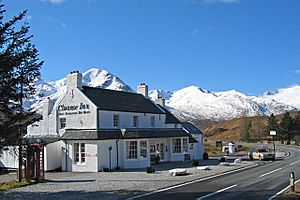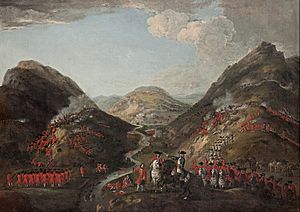Glen Shiel facts for kids
Quick facts for kids Glen Shiel
|
|
|---|---|
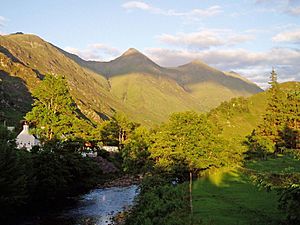 Four of the Five Sisters of Kintail and the river Shiel from Shiel Bridge at the foot of Glen Shiel |
|
| Civil parish |
|
| Council area | |
| Country | Scotland |
| Sovereign state | United Kingdom |
| Postcode district | IV 40, IV 63 |
| Police | Northern |
| Fire | Highlands and Islands |
| Ambulance | Scottish |
| EU Parliament | Scotland |
Glen Shiel (Scottish Gaelic: Gleann Seile), also known as Glenshiel, is a beautiful valley in the Northwest Highlands of Scotland. It's a place with stunning mountains and a rich history.
This valley stretches about 9 miles (14.5 km) from the Cluanie Inn near Loch Cluanie to the village of Shiel Bridge by Loch Duich. The northern part of Glen Shiel is owned by the National Trust for Scotland. The lower area is part of the Kintail National Scenic Area, a special place known for its amazing views.
Contents
Exploring Glen Shiel's Roads
The main road through Glen Shiel is the A87, often called the "Road to the Isles". It runs along the entire valley. The highest point of this road in the glen is about 271 metres (889 feet) high.
You can still see parts of an old military road near the Cluanie Inn. This road was built between 1750 and 1784. It connected Fort Augustus to the Bernera barracks in Glenelg.
Glen Shiel's Amazing Mountains
Glen Shiel is famous for its impressive mountain ranges. These mountains make the valley a popular spot for hikers and nature lovers.
The North Glen Shiel Ridge
On the northern side of the glen, you'll find the North Glen Shiel ridge. This ridge includes the famous Five Sisters of Kintail. These are five stunning peaks: Sgùrr na Ciste Duibhe, Sgùrr na Càrnach, Sgùrr Fhuaran, Sgùrr nan Spàinteach, and Sgùrr nan Saighead. Further up the glen, other peaks like Sàileag, Sgùrr a' Bhealaich Dheirg, and Aonach Meadhoin are part of this ridge.
The South Glen Shiel Ridge
To the south, there's the South Glen Shiel ridge, also called the South Cluanie ridge. This side has peaks like Creag a' Mhàim, Druim Shionnach, Aonach air Chrith, Maol Chinn-dearg, Sgùrr an Doire Leathain, Sgùrr an Lochain, and Creag nan Damh.
Lower down, you'll find The Saddle and Sgùrr na Sgine. These two mountains are often called the best in the area for their unique shapes. You can reach them through smaller valleys that branch off Glen Shiel.

The river running through the valley is called the River Shiel. It flows into Loch Duich, which is a sea loch.
Plants and Animals of Glen Shiel
Glen Shiel is home to many different kinds of plants and animals. It's a great place to see Scottish wildlife.
Trees and Forests
The glen has native trees like common alder, downy birch, sessile oak, and rowan. Some parts of the upper glen have been planted with Scots pine, Sitka spruce, and Norway Spruce. There are plans to bring back more of the original ancient woodlands in this dramatic landscape.

Wildflowers and Wildlife
On the grassy mountain slopes, you might spot beautiful wildflowers. These include fragrant orchids, butterfly orchids, pale butterwort, and mountain azalea.
You can also see herds of red deer roaming freely in the glen. Wild goats also live here.
The Battle of Glen Shiel
Glen Shiel was the site of an important battle on June 10, 1719. This battle was fought between British government forces and a group of Jacobites who were supported by Spanish soldiers. The British forces won the battle.
This was the last time British and foreign troops fought a close battle on the mainland of Great Britain. It's also special because it's "Scotland's only battle site with contemporary remains still visible." You can still see a stone wall where the Jacobite supplies were kept.
The Battle's Location
The Jacobites had a strong position on the rocky hillsides of the glen. They built barricades across the road and dug trenches along the northern side of the river. The main group of fighters included a Spanish regiment, along with Scottish clans like Clan Cameron, Rob Roy MacGregor's men, Clan Mackinnon, and Clan Mackenzie.
The British forces included grenadiers, different regiments, and Scottish clans like the Clan Fraser, Clan Ross, Clan Sutherland, Clan MacKay, and Clan Munro.
Peak of the Spaniards
One of the peaks on the northern side of the glen is called Sgùrr nan Spàinteach, which means "Peak of the Spaniards". This name comes from the 200 Spanish soldiers who fought bravely for the Jacobites. After their defeat, they retreated over this peak.
This peak is part of a larger mountain called Sgùrr na Ciste Duibhe. Its name means "peak of the black chest". Some people thought it was named because the Spanish soldiers might have dropped coins there. However, the "black chest" actually refers to a deep hollow on the mountain's slope.
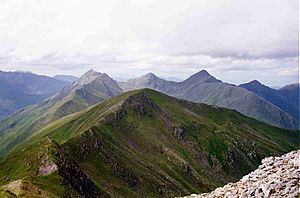
A Famous Painting
A painting called The Battle of Glenshiel 1719 by the artist Peter Tillemans shows the battle. It's a very accurate painting and hangs in the Scottish National Portrait Gallery. It shows important figures like Lord George Murray and Rob Roy MacGregor from the Jacobite side, and General Joseph Wightman from the British side.
Prince Charlie's Stone
On the steep slopes of Sgùrr na Ciste Duibhe, there's a large rock known as "Prince Charlie's Stone". This is where Charles Edward Stuart, also known as "Bonnie Prince Charlie", hid for a day in the summer of 1746. He was hiding from government troops after leaving the Isle of Skye.
At that time, there was a huge reward of £30,000 for his capture! He was on the run after his defeat at the Battle of Culloden. After reaching Glen Shiel, Prince Charles was helped by a group known as the "Seven Men of Glenmoriston". They lived in a cave about 10 miles east of Glen Shiel. They kept the prince safe for a week in July 1746. They made a strong promise to protect him, no matter what.
Images for kids


